|
|
|
[Best viewed with Microsoft Internet Explorer]
![]()
Surely
there is for you, in the Messenger of Allah, an excellent example…
Authentic Ahadith Establishing Hanafi Method of Salaah
![]()
![]()
PUB #A003 2000.07.05
Contents
Masah (passing wet fingers) Over The Nape
Performing Masah Over Ordinary Socks
Prescribed Times For The Five Daily Salaah
Covering of the Head During Salaah
To Raise the Hands upto the Earlobes
To Tie the Hands Beneath the Navel
The Muqtadi (follower behind the imaam)
Should Listen and Remain Silent
The Muqtadi Must Not Recite Surah Fatihah
The Qiraat of the Imaam Suffices for the Muqtadi
The Person Performing Salaah Individually Must
Recite Surah Fatihah, Not the Muqtadi
Not Raising the Hands (up to the shoulders) During Salaah
Proof from the Practice of the Sahaabah (![]() )
)
Jalsatul Istiraaha - Sitting Briefly After The
Second Sajdah Of The First Or Third Rakaat
Raising the Index Finger During Tashahhud
Raising Both the Hands and Making Du’a
Sunnats Before Salaat adh-Dhuhr
Four Rakaats Before Salaat al-‘Isha
Salaam Should Be Made at the End of the Witr Salaah
Qadaa (Makeup) of the Two Rakaats Sunnah of
Salaat al-Fajr
Salaat al-Taraaweeh During The Lifetime Of Rasoolullah
(![]() )
)
Salaat al-Taraaweeh
During the Period of the Rightly-Guided Khulafa (Twenty Rakaat)
Distance Of Shar’i Safar (Travel in the Shariah)
The Duration Of Time Pertaining To Qasr
Manner of standing in the Saff (rows of the jamaat)
![]()
![]()
We praise
Allah, the Exalted and Great, and we send blessings upon His noble Messenger ![]() .
.
Authentic
Ahadith Establising
Hanafi Method
of Salaah
Very often the following question is posed to people: “Do you
follow the Deen (religion) of Imaam Abu Haneefa (![]() ) or
the Deen of Rasoolullah (
) or
the Deen of Rasoolullah (![]() )?”
)?”
“Obviously, the Deen of Rasoolullah (![]() ),”
comes the instant reply.
),”
comes the instant reply.
The second question is then posed: “Why then do you call yourself a Hanafi?”
The person not well versed is perplexed by this question. Doubts
are created in his mind. He soon starts gradually drifting towards the
abandoning of taqleed i.e. following one of the four illustrious Imaams
viz. Imaam Abu Haneefa (![]() ),
Imaam Shafi’i (
),
Imaam Shafi’i (![]() ),
Imaam Maalik (
),
Imaam Maalik (![]() ) and
Imaam Ahmad bin Hanbal (
) and
Imaam Ahmad bin Hanbal (![]() ).
).
By means of the type of questions that have been mentioned above,
a deliberate attempt is made to create a misconception in the minds of the
unwary- that if you are a Hanafi, you are following the Deen of
Imaam Abu Haneefa (![]() ), NOT
the Deen of Muhammad (
), NOT
the Deen of Muhammad (![]() ).
This is an absolute fallacy. Imaam Abu Haneefa (
).
This is an absolute fallacy. Imaam Abu Haneefa (![]() ),
Imaam Shafi’i (
),
Imaam Shafi’i (![]() ) and
the other Imaams did not invent any Deen of their own. They strictly
followed the one and only Deen — the Deen of Islam brought by Rasoolullah
(
) and
the other Imaams did not invent any Deen of their own. They strictly
followed the one and only Deen — the Deen of Islam brought by Rasoolullah
(![]() ).
Their followers are hence also following the same Deen — the Deen
of Rasoolullah (
).
Their followers are hence also following the same Deen — the Deen
of Rasoolullah (![]() ).
).
The question that arises here is why then should one follow any of the four Imaams? This can be answered by posing a counter-question: “Do you know all the various laws of the Deen? Are you capable of extracting and deriving the laws pertaining to wuduu, salaah, zakaah, and so on directly from the Qur’an and Hadith? Do you know which Hadith has abrogated another? Do you have the ability to reconcile between the various Ahadith which apparently contradict each other? Do you know which verses of the Qur’an are general in their application and which verses are qualified by other texts? etc. etc.”
If one does not have the knowledge of these aspects, then one definitely does not have the ability to derive the laws directly from the Qur’an and Hadith. In that case the following aayah applies directly to oneself:
![]()
“Ask those of knowledge if you do not know.” (16:43)
Hence when we do not have the enormous amount of knowledge and
expertise that is necessary to derive laws directly from the Qur’an and Hadith,
we have opted to follow one of those great people who had attained that
distinguished mastery in this field, among whom is Imaam Abu Haneefa (![]() ).
).
Imaam Abu Haneefa (![]() ) was
a Taabi’i (one who has seen a Sahaabi). He attained the knowledge
of Hadith from approximately 4,000 ustaadh (teachers). His piety
was such that for 40 years he performed Fajr salaah with
the wuduu of ‘Isha salaah (i.e. he did not
sleep the entire night)[1]. His knowledge, brilliance and righteousness
was such that all the great scholars of his time attested to his mastery. Thus
one can be well assured that such a person is absolutely capable of deriving
the laws directly from the Qur’an and Hadith.
) was
a Taabi’i (one who has seen a Sahaabi). He attained the knowledge
of Hadith from approximately 4,000 ustaadh (teachers). His piety
was such that for 40 years he performed Fajr salaah with
the wuduu of ‘Isha salaah (i.e. he did not
sleep the entire night)[1]. His knowledge, brilliance and righteousness
was such that all the great scholars of his time attested to his mastery. Thus
one can be well assured that such a person is absolutely capable of deriving
the laws directly from the Qur’an and Hadith.
Another reason for adopting one of the Imaams as a guide is the following aayah of the Qur’an where Allah Ta’ala says:
![]()
“And follow the path of those who turn to me” (31:15)
In order to “turn” to Allah Ta’ala, two aspects are basic
requisites— knowledge and practice according to that knowledge. In this regard
the four Imaams were in an extremely high category. Imaam Abu Haneefa (![]() ) was
regarded by various ‘Ulama of his time as being the most knowledgeable
of the people of that era.[2] Makki bin Ibrahim, who was one of the
renowned ustaadhs of Imaam Bukhaari (
) was
regarded by various ‘Ulama of his time as being the most knowledgeable
of the people of that era.[2] Makki bin Ibrahim, who was one of the
renowned ustaadhs of Imaam Bukhaari (![]() ),
was a student of Imaam Abu Haneefa (
),
was a student of Imaam Abu Haneefa (![]() ). Imaam Abu Haneefa (
). Imaam Abu Haneefa (![]() )
compiled a book of Hadith entitled “Kitaabul Aathaar” from among
40,000 Ahadith. Thus those who follow such a guide can be satisfied that
they are strictly following the commands of Allah Ta’ala and His Rasool
(
)
compiled a book of Hadith entitled “Kitaabul Aathaar” from among
40,000 Ahadith. Thus those who follow such a guide can be satisfied that
they are strictly following the commands of Allah Ta’ala and His Rasool
(![]() ).
).
At this point somebody may ask: “If all the Imaams deduced the laws directly from the Qur’an and Hadith, how is it possible for them to differ on various aspects?”
In order to understand the reality of these differences, we will
have to go back in history right up to the time of the Sahaabah (![]() ):
):
Once Rasoolullah (![]() ) had
just returned from a battle when he ordered the Sahaabah to
immediately proceed to the place of Banu Quraizah— a clan of Jews who
lived on the outskirts of Madina Munawwarah. The purpose was to lay a
siege upon them for having broken the pact that they had made with the Muslims.
In order to impress the urgency of the matter upon the Sahaabah, Rasoolullah
(
) had
just returned from a battle when he ordered the Sahaabah to
immediately proceed to the place of Banu Quraizah— a clan of Jews who
lived on the outskirts of Madina Munawwarah. The purpose was to lay a
siege upon them for having broken the pact that they had made with the Muslims.
In order to impress the urgency of the matter upon the Sahaabah, Rasoolullah
(![]() )
said to them: “None of you should perform your salaatul-‘Asr except
in Banu Quraizah.” While the Sahaabah were still en-route, the
time of ‘Asr arrived. Some Sahaabah felt that they
should perform their ‘Asr immediately. They regarded the
instruction of Rasoolullah (
)
said to them: “None of you should perform your salaatul-‘Asr except
in Banu Quraizah.” While the Sahaabah were still en-route, the
time of ‘Asr arrived. Some Sahaabah felt that they
should perform their ‘Asr immediately. They regarded the
instruction of Rasoolullah (![]() ) as
actually being a command to proceed very swiftly to their destination. It did
not imply that the ‘Asr salaah could not be performed
en-route. They thus performed their salaah there. Another group
of Sahaabah (
) as
actually being a command to proceed very swiftly to their destination. It did
not imply that the ‘Asr salaah could not be performed
en-route. They thus performed their salaah there. Another group
of Sahaabah (![]() )
viewed the instruction literally. They therefore continued and only performed
their ‘Asr salaah after having reached Banu Quraizah.
Later when Rasoolullah (
)
viewed the instruction literally. They therefore continued and only performed
their ‘Asr salaah after having reached Banu Quraizah.
Later when Rasoolullah (![]() ) was
informed about this, he did not rebuke either group.[3]
) was
informed about this, he did not rebuke either group.[3]
Thus we find that the difference arose from a point of
interpretation. However, this difference of interpretation is only entertained
when it comes from a person who has in-depth knowledge of Deen and has
attained a mastery of the Qur’an and Hadith and the other related
aspects. At times a difference of opinion occurs due to the different
narrations that are found with regards to a particular aspect. One Imaam
gives preference to one narration on the basis of various criteria while the
other Imaam, in the light of his knowledge, prefers the other narration.
This is basically the manner in which these differences occur. However, just as
Rasoolullah (![]() ) did
not rebuke either of the two groups in the incident mentioned above, similarly
since the Imaams have attained the status of a mujtahid (one who
is capable of deriving the laws directly from the Qur’an and Hadith),
they will not be blameworthy even if they have erred.
) did
not rebuke either of the two groups in the incident mentioned above, similarly
since the Imaams have attained the status of a mujtahid (one who
is capable of deriving the laws directly from the Qur’an and Hadith),
they will not be blameworthy even if they have erred.
Rasoolullah (![]() ) is
reported to have said:
) is
reported to have said:
“When a haakim (ruler) passes judgement, and after having exerted his utmost effort he arrives at the correct solution, he gets a double reward. And if he errs after having exerted his utmost ability, he gets one reward.”[4]
Ibn al-Munzir (![]() )
while commenting on this Hadith writes that a ruler will only get this
reward if he has thorough knowledge and in the light of his knowledge he passed
judgement (see footnotes of Saheeh Bukhaari). The four Imaams had
the ability and necessary knowledge to practice ijtihaad. Thus they fall
under the ambit of this Hadith.
)
while commenting on this Hadith writes that a ruler will only get this
reward if he has thorough knowledge and in the light of his knowledge he passed
judgement (see footnotes of Saheeh Bukhaari). The four Imaams had
the ability and necessary knowledge to practice ijtihaad. Thus they fall
under the ambit of this Hadith.
Another point that often comes up is the following: “Why is it necessary to follow one Imaam only? Why can one not follow a certain Imaam in one aspect and another Imaam in another aspect?”
The simple answer to this is: On what basis will one pick and
choose, especially since one does not have the knowledge required to derive the
laws? Thus one will not be in a position to evaluate the deductions of each Imaam.
Hence it will obviously be on the basis of what suits one. This is nothing but
following one’s desires— regarding which Allah Ta’ala has issued severe
warnings in the Qur’an. Following one’s desires sometimes even leads a
person to kufr. Thus, great jurists of latter times, among them Shah
Waliullah (![]() ),
have reaffirmed that it is waajib (compulsory) for the masses to follow
one Imaam only.
),
have reaffirmed that it is waajib (compulsory) for the masses to follow
one Imaam only.
Here one more point needs clarification with regards to the authenticity of Ahadith. The general masses are made to believe that a Hadith is only authentic if it is related in Saheeh al-Bukhaari and/or Saheeh Muslim. This is a misconception. The authenticity of the Hadith is based on its chain of narrators, irrespective of whether it appears in any one of the Sihaah Sitta (the famous six authentic compilations of Hadith) or in any other compilation besides these. Imaam Muslim has written in his Muqqadama (introduction to Saheeh Muslim) that he has not recorded every authentic Hadith in his Saheeh. Actually, according to Imaam Bukhaari and Imaam Muslim, there are more authentic Ahadith which are not recorded in Saheeh al-Bukhaari and Saheeh Muslim than the number of narrations contained in these two books.
The Hanafi madhhab is derived directly from the Qur’an and Hadith, like all the other madhhabs. However, to truly appreciate the conformity of the Hanafi madhhab with the Hadith, one will have to undertake a thorough study of the following books of Hadith: (1) Sharah Ma’anil Aathaar (2) Al-jawharan-Naqi (3) Nasbur Raayah (4) I’la as-Sunan (5) Bazlul Majhood (6) Fathul Mulhim (7) Awjazul Masaalik (8) Aathaarus Sunan, and many others.
It has already been explained above that the differences between the Imaams are based on the different narrations or the difference of interpretation. However, all the Imaams have their proofs from the Qur’an and Sunnah. Thus it is the duty of every person, while strictly following his Imaam, to respect and honour the other Imaams and their followers.
Nevertheless, in this belated age there are many people who have
cast aside the following of any of the four Imaams completely. Instead,
while claiming to follow the Qur’an and Hadith directly, they in
reality have begun to follow the interpretations of (make taqleed of!)
some modern day ghair muqallid (one who has abandoned taqleed).
However, coupled with this, they will often be found denigrating the followers
of an Imaam and classifying them as people following the Deen of
Imaam Abu Haneefa and others— not the Deen
of Rasoolullah (![]() ).
They make themselves out as being the only ones who follow Hadith while
all others are regarded as being contradictory to the Hadith.
).
They make themselves out as being the only ones who follow Hadith while
all others are regarded as being contradictory to the Hadith.
Many people have become entrapped in this propaganda. Thus this
book sets out to explain proofs of specifically those aspects regarding which
the Hanafis are generally made a target of abuse. The purpose is to
simply bring to the attention of the unwary person that he is following the Deen
of Rasoolullah (![]() )—
not some other Deen. This book is not intended to create a climate of
debate and argument. As already explained, all the Imaams have their
proofs. In this small book only one or two ahadith have been presented
under the selected topics, simply to demonstrate the accordance of the Hanafi
madhhab with the practice of the Prophet (
)—
not some other Deen. This book is not intended to create a climate of
debate and argument. As already explained, all the Imaams have their
proofs. In this small book only one or two ahadith have been presented
under the selected topics, simply to demonstrate the accordance of the Hanafi
madhhab with the practice of the Prophet (![]() ) and
the Sahaabah (
) and
the Sahaabah (![]() ).
It is hoped that by the means of this book the baseless propaganda against
those who follow any one of the four illustrious Imaams will be halted
in its tracks.
).
It is hoped that by the means of this book the baseless propaganda against
those who follow any one of the four illustrious Imaams will be halted
in its tracks.
Initially a very detailed book on this topic was written in Urdu by Shaikh Muhammad Ilyas Faisal of Madina Munawwarah. A concise version was later published. This is the English rendering of the concise version which was translated by Moulana Abdul Qadir Vawda of Madrasah Taaleemuddeen. Some additions and alterations have been made where it was deemed appropriate. It must also be pointed out that every narration quoted in this booklet is highly authentic and of such a category which, according to the muhadditheen, can be used to derive the laws of Deen from it. May Allah Ta’ala accept this humble effort and make it a means of assisting in our salvation on the day of Qiyaamah.
Aameen.
![]()

Hazrat Uthmaan (![]() )
once asked: “Should I not show you the manner in which Rasoolullah (
)
once asked: “Should I not show you the manner in which Rasoolullah (![]() )
performed his wuduu?” Thereafter he performed wuduu
in such a manner that he washed every limb thrice.[5]
)
performed his wuduu?” Thereafter he performed wuduu
in such a manner that he washed every limb thrice.[5]
Masah (passing wet fingers) Over The Nape
![]()

Hazrat ‘Abdullah Ibn ‘Umar (![]() )
narrates that Rasoolullah (
)
narrates that Rasoolullah (![]() )
said: “Whoever performs wuduu and makes masah over his nape, he
will be saved from wearing a necklace (of fire) around his neck on the the day
of judgement.”
)
said: “Whoever performs wuduu and makes masah over his nape, he
will be saved from wearing a necklace (of fire) around his neck on the the day
of judgement.”
The famous commentator of Saheeh
al-Bukhaari, Allamah Ibn Hajar Asqalaani (![]() ),
writes in his book Talkheesul Habeer [vol. 1: p.92] that this narration is Saheeh.
Allamah Shawkaani (
),
writes in his book Talkheesul Habeer [vol. 1: p.92] that this narration is Saheeh.
Allamah Shawkaani (![]() ) has
also affirmed this in Naylul Awtaar [vol. 1: p.204].
) has
also affirmed this in Naylul Awtaar [vol. 1: p.204].
Performing Masah Over Ordinary Socks
That is, cotton, woolen, polyester, etc. It is not permissible to make masah over ordinary socks (cotton, woolen, nylon, etc.— i.e. all socks other than leather socks) in wuduu. There is no authentic narration sanctioning this practice. In the commentary of Tirmidhi, Tuhfatul Ahwazee, the famous Ahle Hadith scholar Allamah Mubarakpuri, has written that this practice of making masah on woolen, cotton, nylon socks and socks made from similar materials is not established from any authentic Hadith (vol. 1, pg.333). Many other high ranking scholars of the ghair muqallid sect (those who do not prescribe to taqleed) have refuted this practice themselves and declared it as impermissible. [See Fatawa Nazeeriah; 1:423.][6]
Prescribed Times For The Five Daily Salaah
![]()
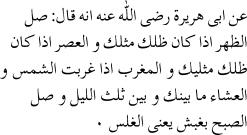
Hazrat Abu Huraira (![]() )
narrates: “When the length of your shadow (from the sun) is equal to your
height then perform the Dhuhr salaah. When the length of your
shadow becomes twice your height, perform the ‘Asr salaah.
Perform the Maghrib salaah when the sun has set. Perform
the ‘Isha salaah before one-third (1/3) of the night
passes. And perform the Fajr salaah while it is still
dark.”[7]
)
narrates: “When the length of your shadow (from the sun) is equal to your
height then perform the Dhuhr salaah. When the length of your
shadow becomes twice your height, perform the ‘Asr salaah.
Perform the Maghrib salaah when the sun has set. Perform
the ‘Isha salaah before one-third (1/3) of the night
passes. And perform the Fajr salaah while it is still
dark.”[7]
![]()

Rasoolullah (![]() ) has
said: “When the heat becomes very intense (after mid-day), then delay the Dhuhr
salaah until it cools down, for verily the intensity of the heat
is from the effects of Jahannam.”[8]
) has
said: “When the heat becomes very intense (after mid-day), then delay the Dhuhr
salaah until it cools down, for verily the intensity of the heat
is from the effects of Jahannam.”[8]
![]()

It was the noble habit of Rasoolullah (![]() )
that he used to delay the performance of ‘Asr so long as the sun
remained white and clear.[9]
)
that he used to delay the performance of ‘Asr so long as the sun
remained white and clear.[9]
![]()

Rasoolullah (![]() ) is
reported to have said: “Perform the Fajr salaah when the
sky brightens at the time of dawn (i.e. before sunrise) since this is a means
of earning greater reward.”[10]
) is
reported to have said: “Perform the Fajr salaah when the
sky brightens at the time of dawn (i.e. before sunrise) since this is a means
of earning greater reward.”[10]
Imaam Tirmidhi explains that a number of the Sahaaba (![]() )
used to perform Fajr salaah at this time (i.e. when the
sky had brightened up somewhat).
)
used to perform Fajr salaah at this time (i.e. when the
sky had brightened up somewhat).
![]()
![]()
Hazrat Bilaal (![]() ), Rasoolullah’s
(
), Rasoolullah’s
(![]() ) muadh-dhin,
used to call out the words of adhaan and iqaamah twice.
) muadh-dhin,
used to call out the words of adhaan and iqaamah twice.
[This Hadith is classified as Saheeh— Musannaf Abdur Razzaak; see Aathaarus Sunan vol.1: pg. 53.]
The muadh-dhins of Rasoolullah (![]() ),
Abu Mahzoora (
),
Abu Mahzoora (![]() ) and
Thaubaan (
) and
Thaubaan (![]() )
also used to call out the adhaan and iqaamah in the above
mentioned manner (i.e. by saying the words twice). Allaamah Shawkaani (
)
also used to call out the adhaan and iqaamah in the above
mentioned manner (i.e. by saying the words twice). Allaamah Shawkaani (![]() ) has
affirmed the authenticity of the above narrations in Naylul Autaar [vol.2. pg.24].
) has
affirmed the authenticity of the above narrations in Naylul Autaar [vol.2. pg.24].
Covering of the Head During Salaah
Ibn ‘Umar (![]() )
narrates that Rasoolullah (
)
narrates that Rasoolullah (![]() )
wore a white hat.
)
wore a white hat.
[Tabarani— Allaama Suyuti has classified this Hadith as highly authentic: see Sirajul Muneer; vol. 4: pg.112.]
It is written in Fataawa Thunaaiyya [vol. 1: pg. 525], and
in the Fatawaa of the Ahle Hadith Scholars [vol. 4: pg.291] that Rasoolullah (![]() )
always used to keep his mubaarak (blessed) head covered during salaah.
In the same books it is also mentioned that to intentionally remove the
headgear (hat) and perform salaah bareheaded is contrary to the sunnah
[vol. 1: pg.523].
)
always used to keep his mubaarak (blessed) head covered during salaah.
In the same books it is also mentioned that to intentionally remove the
headgear (hat) and perform salaah bareheaded is contrary to the sunnah
[vol. 1: pg.523].
To Raise the Hands upto the Earlobes
![]()

Hazrat Qataada (![]() )
relates that he saw Rasoolullah (
)
relates that he saw Rasoolullah (![]() )
performing his salaah. He relates that Rasoolullah (
)
performing his salaah. He relates that Rasoolullah (![]() )
used to lift his hands until they were in line with his earlobes (ie.
when he began his prayer with Allaahu akbar).[11]
)
used to lift his hands until they were in line with his earlobes (ie.
when he began his prayer with Allaahu akbar).[11]
To Tie the Hands Beneath the Navel
![]()
![]()
Hazrat ‘Ali (![]() )
relates that the sunnah of Rasoolullah (
)
relates that the sunnah of Rasoolullah (![]() ) is
to place one hand over the other below the navel.[12]
) is
to place one hand over the other below the navel.[12]
The above-mentioned method of tying the hands is also related by
Hazrat Anas (![]() ).
).
![]()

Hazrat ‘Umar (![]() )
used to recite the following thana (du’aa after the first takbeer)
in prayer:[13]
)
used to recite the following thana (du’aa after the first takbeer)
in prayer:[13]

![]()

Hazrat Anas (![]() )
states, “I have performed congregational salaah behind Rasoolullah
(
)
states, “I have performed congregational salaah behind Rasoolullah
(![]() ),
Abu Bakr, Umar and Uthmaan (Allah be pleased with them) and I did not hear any
one of them recite Bismillahir rahmaan nir raheem.”[14]
),
Abu Bakr, Umar and Uthmaan (Allah be pleased with them) and I did not hear any
one of them recite Bismillahir rahmaan nir raheem.”[14]
Imaam Tirmidhi (![]() )
states that the majority of the Sahaaba (
)
states that the majority of the Sahaaba (![]() )
also used to recite Bismillah softly.
)
also used to recite Bismillah softly.
The Muqtadi (follower behind the imaam) Should Listen and Remain Silent
![]()
Allah Ta’ala says:

“When the Qur’an is being recited then listen attentively and remain silent so that Rahmah will be showered upon you.” (Surah A’raaf)
Hazrat ‘Abdullah Ibn Mas’ud, Abu Hurairah, ‘Abdullah Ibn ‘Abbas
and ‘Abdullah Ibn Mughaffal (![]() )
state that this verse of the Qur’an was revealed with regards to the Khutbah
(of Jumu’ah) and with regards to Salaah.[15]
)
state that this verse of the Qur’an was revealed with regards to the Khutbah
(of Jumu’ah) and with regards to Salaah.[15]
The dictates of this verse of the Holy Qur’an is that when the Imaam recites the Qur’an aloud, the followers should listen attentively, and when he recites softly, the followers should remain silent.
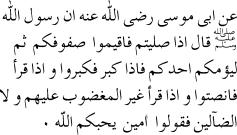
Rasoolullah (![]() ) is
reported to have said: “When you begin your congregational prayers, straighten
your rows. Thereafter when the Imaam says the takbeer (i.e. when
he says Allahu Akbar aloud) you must also say the takbeer.
However, when he begins the recital of the Qur’an, you must remain
silent. And when he recites walad daaul leen then you should say Aameen.
By performing your salaah in this manner Allah Ta’ala will
love you.”[16]
) is
reported to have said: “When you begin your congregational prayers, straighten
your rows. Thereafter when the Imaam says the takbeer (i.e. when
he says Allahu Akbar aloud) you must also say the takbeer.
However, when he begins the recital of the Qur’an, you must remain
silent. And when he recites walad daaul leen then you should say Aameen.
By performing your salaah in this manner Allah Ta’ala will
love you.”[16]
A similar Hadith has been narrated by Abu Hurairah (![]() )-
Imaam Muslim has attested to its authenticity.
)-
Imaam Muslim has attested to its authenticity.
The Muqtadi Must Not Recite Surah Fatihah
![]()

It is reported from Hazrat Ataa Ibn Yasaar (![]() )
that he questioned Hazrat Zaid Ibn Thaabit (
)
that he questioned Hazrat Zaid Ibn Thaabit (![]() )
concerning reciting Qira’at with the Imaam. Hazrat Zaid (
)
concerning reciting Qira’at with the Imaam. Hazrat Zaid (![]() )
answered: “There is no recitation of the Glorious Qur’an in any salaah
behind the Imaam.”[17]
)
answered: “There is no recitation of the Glorious Qur’an in any salaah
behind the Imaam.”[17]
The Qiraat of the Imaam Suffices for the Muqtadi
![]()

Hazrat ‘Abdullah Ibn ‘Umar (![]() )
used to repeatedly say: “Whoever performs salaah behind the Imaam,
the Imaam’s qiraat suffices for him.”
)
used to repeatedly say: “Whoever performs salaah behind the Imaam,
the Imaam’s qiraat suffices for him.”
[Sunan
Baihaqi:
Chapter on not reciting qiraat behind the Imaam— Imaam Baihaqi (![]() ) has
stated that this Hadith is Saheeh.]
) has
stated that this Hadith is Saheeh.]
The Person Performing Salaah Individually Must Recite Surah Fatihah, Not the Muqtadi
![]()
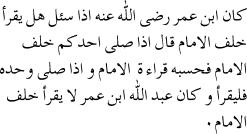
Hazrat ‘Abdullah Ibn ‘Umar (![]() ) was
asked: “Must the muqtadi recite behind the Imaam?” He replied
that the qiraat of the Imaam is sufficient for the muqtadi.
But if he performs salaah individually, then he must recite qiraat.
It was the practice of Hazrat ‘Abdullah Ibn ‘Umar (
) was
asked: “Must the muqtadi recite behind the Imaam?” He replied
that the qiraat of the Imaam is sufficient for the muqtadi.
But if he performs salaah individually, then he must recite qiraat.
It was the practice of Hazrat ‘Abdullah Ibn ‘Umar (![]() )
also that he would not recite Surah Fatihah behind the Imaam.
)
also that he would not recite Surah Fatihah behind the Imaam.
[In Aathaarus Sunan, vol. 1: pg.89, this Hadith has been classified as Saheeh.]

Hazrat Jaabir (![]() )
narrates that the one who does not recite Surah Fatihah even in
one rakaat, his salaah is not valid. However, if he is
behind an Imaam he must not recite Surah Fatihah.[18]
)
narrates that the one who does not recite Surah Fatihah even in
one rakaat, his salaah is not valid. However, if he is
behind an Imaam he must not recite Surah Fatihah.[18]
[This Hadith has been classified as hasan in Tirmidhi.]
It is on the basis of this Hadith that Imaam Tirmidhi (![]() ) has
narrated from Imaam Ahmad bin Hanbal (
) has
narrated from Imaam Ahmad bin Hanbal (![]() )
[who was the teacher of the ustaadh of Imaam Bukhaari (
)
[who was the teacher of the ustaadh of Imaam Bukhaari (![]() )]
that the narration, “Whoever does not recite Surah Fatihah his salaah
is not complete,” refers to one who performs his salaah alone. It
does not include the muqtadi. In the above Hadith it is very
clearly mentioned that the muqtadi must not recite Surah Fatihah.
)]
that the narration, “Whoever does not recite Surah Fatihah his salaah
is not complete,” refers to one who performs his salaah alone. It
does not include the muqtadi. In the above Hadith it is very
clearly mentioned that the muqtadi must not recite Surah Fatihah.
![]()
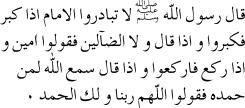
Rasoolullah (![]() ) is
reported to have said: “Do not hasten before the Imaam! When he says the
takbeer, then you should do the same. When he recites Walad-daaul-leen,
then you should say Aameen. When he makes ruku’ then you should
make ruku’. And when he says sami’-Allahu liman hamidah then you
should say Allahumma Rabbana wa lakal hamd.”[19]
) is
reported to have said: “Do not hasten before the Imaam! When he says the
takbeer, then you should do the same. When he recites Walad-daaul-leen,
then you should say Aameen. When he makes ruku’ then you should
make ruku’. And when he says sami’-Allahu liman hamidah then you
should say Allahumma Rabbana wa lakal hamd.”[19]
With regards to the saying of Aameen this narration is
very clear and explicit. Like in the case where the Imaam says Allahu
Akbar and sami’-Allahu liman hamidah aloud, but all the followers
say “Allahu Akbar”and “Rabbana lakal hamd” softly. In the same
manner when the Imaam recites “walad daul leen” aloud, the
followers should say Aameen softly. It is also reported from Abu Ma’mar
that ‘Umar (![]() )
used to say: “The Imaam will recite four things softly-Ta’awwuz, Bismillah,
Aameen and Rabbana Lakalhamd” [Aini, vol. 1: pg. 620]
)
used to say: “The Imaam will recite four things softly-Ta’awwuz, Bismillah,
Aameen and Rabbana Lakalhamd” [Aini, vol. 1: pg. 620]
Not Raising the Hands (up to the shoulders) During Salaah
![]()
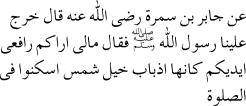
Hazrat Jaabir Ibn Samurah (![]() )
relates that once Rasoolullah (
)
relates that once Rasoolullah (![]() )
came out of his house towards us and said: “Why is it that I see you all
raising your hands as though they are the tails of stubborn horses. Be tranquil
in salaah”.[20]
)
came out of his house towards us and said: “Why is it that I see you all
raising your hands as though they are the tails of stubborn horses. Be tranquil
in salaah”.[20]
This hadith alone makes it clear that those narrations which mention the raising of the hands (during the salaah) were narrated prior to the prohibition of this practice.
Practice of Rasoolullah (![]() )
)
![]()

Hazrat ‘Abdullah Ibn Mas’ud (![]() )
said: “Shall I not show you the manner in which Rasoolullah (
)
said: “Shall I not show you the manner in which Rasoolullah (![]() )
performed his salaah?” Thereafter he performed the salaah
but he did not raise his hands except at the beginning (of his salaah).[21]
)
performed his salaah?” Thereafter he performed the salaah
but he did not raise his hands except at the beginning (of his salaah).[21]
This Hadith is classified Hasan. Ibn Hazm (![]() ) has
declared it as Saheeh. Ahmed Shakir (
) has
declared it as Saheeh. Ahmed Shakir (![]() ) has
also declared it as Saheeh.
) has
also declared it as Saheeh.
![]()

It is related that Hazrat ‘Ali (![]() )
used to raise his hands at the time of the first Takbeer (during his salaah).
Thereafter he did not raise them.
)
used to raise his hands at the time of the first Takbeer (during his salaah).
Thereafter he did not raise them.
[Sunan al-Bayhaqi]
The commentators of Bukhaari Shareef, Allaama Ibn Hajar,
Allaama Zayla’i and Allaama ‘Aini (![]() )
have said that this narration and its chain of narrators is Saheeh.
)
have said that this narration and its chain of narrators is Saheeh.
One should take note of the fact that the practice of Hazrat
‘Umar, the remaining Khulafa-e-Raashideen, Hazrat ‘Abdullah Ibn Mas’ud
and many more Sahaabah (![]() )
was the same, that they only raised their hands at the time of the first takbeer.
Imaam Tirmidhi (
)
was the same, that they only raised their hands at the time of the first takbeer.
Imaam Tirmidhi (![]() )
also states that this was the practice of a great number of the Sahaabah
(
)
also states that this was the practice of a great number of the Sahaabah
(![]() ).
).
Not Sitting Briefly After The Second Sajdah Of The First Or Third Rakaat (Jalsatul Istiraaha)
![]()
![]()
In a narration from the Ibn Sahl (![]() ) it
is mentioned that Rasoolullah (
) it
is mentioned that Rasoolullah (![]() )
said the takbeer and simultaneously went into sajdah. Then he
said the takbeer and simultaneously stood up erect without sitting.[22]
)
said the takbeer and simultaneously went into sajdah. Then he
said the takbeer and simultaneously stood up erect without sitting.[22]
Imaam Bayhaqi (![]() ) has
recorded in his Sunan that this was the practice of Hazrat ‘Abdullah Ibn
Mas’ud (
) has
recorded in his Sunan that this was the practice of Hazrat ‘Abdullah Ibn
Mas’ud (![]() ).
Allaama Zayla’i (
).
Allaama Zayla’i (![]() ) has
recorded in Nasabur Raayah that the same procedure was the practice of
Hazrat ‘Umar, ‘Ali, ‘Abdullah Ibn Zubair and ‘Abdullah Ibn ‘Abbaas (
) has
recorded in Nasabur Raayah that the same procedure was the practice of
Hazrat ‘Umar, ‘Ali, ‘Abdullah Ibn Zubair and ‘Abdullah Ibn ‘Abbaas (![]() ). [vol. 1: pg. 289]
). [vol. 1: pg. 289]
Likewise, Allaamah Turkumaani has recorded in Jauharun Naqi regarding
several Sahaaba (![]() )
that it was their practice that after the first and third rakaat they
would stand up straight from sajdah without sitting. [vol. 1: pg. 125]
)
that it was their practice that after the first and third rakaat they
would stand up straight from sajdah without sitting. [vol. 1: pg. 125]
![]()
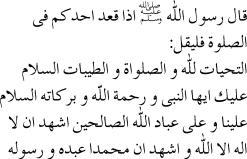
![]()
Rasoolullah (![]() ) is
reported to have said: “When you sit during salaah (for Qa’dah
Akheerah, the final sitting) read the following:
) is
reported to have said: “When you sit during salaah (for Qa’dah
Akheerah, the final sitting) read the following:
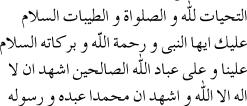
‘All oral, physical and monetary worship is due to Allah alone.
Salutations to you Oh Nabi, and the mercy and blessings of Allah be upon
you. Peace be upon us and upon all the righteous servants of Allah. I bear
witness that none is worthy of worship besides Allah and that Muhammad (![]() ) is
his servant and messenger.’ Thereafter he would choose from the supplications
whatever he wished.”[23]
) is
his servant and messenger.’ Thereafter he would choose from the supplications
whatever he wished.”[23]
Pointing the Index Finger During Tashahhud
![]()
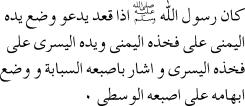
It is narrated that when Rasoolullah (![]() )
used to sit down to supplicate, (to recite tashahhud) he used to place
his right hand on his right thigh and his left hand on his left thigh. He would
indicate (at the time of reciting the shahadah) by pointing his index
finger. He would also join the ends of his thumb and middle finger (thereby
forming a circle).[24]
)
used to sit down to supplicate, (to recite tashahhud) he used to place
his right hand on his right thigh and his left hand on his left thigh. He would
indicate (at the time of reciting the shahadah) by pointing his index
finger. He would also join the ends of his thumb and middle finger (thereby
forming a circle).[24]
![]()
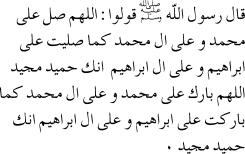
The Sahaabah-e-Kiraam (![]() )
inquired from Rasoolullah (
)
inquired from Rasoolullah (![]() ) as
to which durood should they recite (during salaah). Rasoolullah
(
) as
to which durood should they recite (during salaah). Rasoolullah
(![]() )
replied: “Recite the following durood (trans.): ‘Oh Allah shower your mercy
upon Muhammad (
)
replied: “Recite the following durood (trans.): ‘Oh Allah shower your mercy
upon Muhammad (![]() ) and
the family of Muhammad (
) and
the family of Muhammad (![]() ) as
you have showered your mercy upon Ibrahim (
) as
you have showered your mercy upon Ibrahim (![]() ) and
the family of Ibrahim (
) and
the family of Ibrahim (![]() ).
Behold, you are Praiseworthy, Glorious. O Allah shower your blessings upon
Muhammad (
).
Behold, you are Praiseworthy, Glorious. O Allah shower your blessings upon
Muhammad (![]() ) and
the family of Muhammad (
) and
the family of Muhammad (![]() ) as
you have showered your blessings upon Ibrahim (
) as
you have showered your blessings upon Ibrahim (![]() ) and
the family of Ibrahim (
) and
the family of Ibrahim (![]() ).
Behold, you are Praiseworthy, Glorious.’”
).
Behold, you are Praiseworthy, Glorious.’”
Raising Both the Hands and Making Du’a
![]()
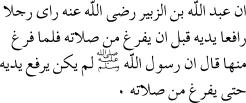
It is narrated that ‘Abdullah Ibn Zubair (![]() ) saw
a man raising his hands and making du’a before completing his salaah.
When the person had completed his salaah, Hazrat ‘Abdullah Ibn
Zubair (
) saw
a man raising his hands and making du’a before completing his salaah.
When the person had completed his salaah, Hazrat ‘Abdullah Ibn
Zubair (![]() )
went up to him and said: “Verily, Rasoolullah (
)
went up to him and said: “Verily, Rasoolullah (![]() )
used to only raise his hands and make du’a after completing his salaah.”
)
used to only raise his hands and make du’a after completing his salaah.”
[The narrators of this Hadith are all trustworthy: Majma-uz-Zawaaid, vol. 1, pg. 169.]
It is also mentioned in the Fataawa of Ahle Hadith [vol. 1, pg.190] as well as in Fataawa Nazeeriyyaa [vol. 1, pg. 566] that in the light of the Shari’ah, the dua after salaah is an authentically established practice and it is mustahab to do so.
Sunnats Before Salaat adh-Dhuhr
![]()

Rasoolullah (![]() ) has
said: “Whoever performs four rakaats before the fard of dhuhr
and four rakaats after it, Allah Ta’ala will make him haraam
upon the fire of Jahannam.”[25]
) has
said: “Whoever performs four rakaats before the fard of dhuhr
and four rakaats after it, Allah Ta’ala will make him haraam
upon the fire of Jahannam.”[25]
![]()

Rasoolullah (![]() ) has
said: “May Allah show mercy upon that person who performs four rakaats
before the fard of ‘Asr.”[26]
) has
said: “May Allah show mercy upon that person who performs four rakaats
before the fard of ‘Asr.”[26]
![]()
![]()
Hazrat Abu Ma’mar (![]() ) has
said that the Sahaabah (
) has
said that the Sahaabah (![]() )
used to consider 4 rakaats after the fard of Maghrib
to be mustahab.
)
used to consider 4 rakaats after the fard of Maghrib
to be mustahab.
[Qiyaamul-Layl of Marwazi pg.58. See also Tirmidhi.]
Four Rakaats Before Salaat al-‘Isha
![]()
![]()
Hazrat Sa’eed Ibn Jubair (![]() )
narrates that the Sahaabah (
)
narrates that the Sahaabah (![]() )
used to regard the performing of four rakaats before the fard
of ‘Isha as mustahab.
)
used to regard the performing of four rakaats before the fard
of ‘Isha as mustahab.
[ibid. pg.58]
![]()
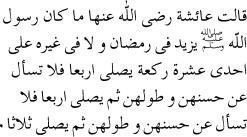
Hazrat Aa’ishah (![]() )
is reported to have said (with regards to the tahajjud salaah
of Rasoolullah (
)
is reported to have said (with regards to the tahajjud salaah
of Rasoolullah (![]() ):
“He (
):
“He (![]() )
never used to perform more than eleven rakaats, whether in Ramadaan
or out of Ramadaan. Rasoolullah (
)
never used to perform more than eleven rakaats, whether in Ramadaan
or out of Ramadaan. Rasoolullah (![]() )
would perform long rakaats in two units of four rakaats each with
such excellence and devotion which cannot be described. Thereafter he would
perform three rakaats (of witr salaah).”[27]
)
would perform long rakaats in two units of four rakaats each with
such excellence and devotion which cannot be described. Thereafter he would
perform three rakaats (of witr salaah).”[27]
![]()
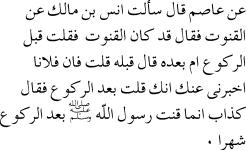
Hazrat ‘Aasim (![]() )
narrates: “I inquired from Hazrat Anas Ibn Malik (
)
narrates: “I inquired from Hazrat Anas Ibn Malik (![]() )
concerning the qunoot of witr. He affirmed its occurrence in the
witr salaah. Then I asked whether it should be recited before the
ruku’ or after it. He replied: “It should be recited before the ruku’.”
I then informed him of a certain person who had heard him (Hazrat Anas
)
concerning the qunoot of witr. He affirmed its occurrence in the
witr salaah. Then I asked whether it should be recited before the
ruku’ or after it. He replied: “It should be recited before the ruku’.”
I then informed him of a certain person who had heard him (Hazrat Anas ![]() )
saying that it should be recited after ruku’. Hazrat Anas (
)
saying that it should be recited after ruku’. Hazrat Anas (![]() )
most vehemently denied this.” Furthermore he said: “Rasoolullah (
)
most vehemently denied this.” Furthermore he said: “Rasoolullah (![]() )
recited the qunoot after the ruku’ for only one month (referring
to the qunootun naazilah).”[28]
)
recited the qunoot after the ruku’ for only one month (referring
to the qunootun naazilah).”[28]
In Musannaf Ibn Abi Shaybah it is mentioned that for this
very reason the Sahaaba-e-Kiraam (![]() )
used to recite the qunoot before ruku’.
)
used to recite the qunoot before ruku’.
Allaama Ibn Hajar (![]() )
writes in his commentary on Bukhaari, Fathul-Baari, that after analyzing all these
narrations we learn that it was the normal practice to recite the qunoot
before ruku’. However on certain
occasions (such as the befalling of a calamity, etc.) the qunoot would
be recited after ruku’. [vol. 1, pg. 291]
)
writes in his commentary on Bukhaari, Fathul-Baari, that after analyzing all these
narrations we learn that it was the normal practice to recite the qunoot
before ruku’. However on certain
occasions (such as the befalling of a calamity, etc.) the qunoot would
be recited after ruku’. [vol. 1, pg. 291]
Salaam Should Be Made at the End of the Witr Salaah
![]()

Hazrat Aa’ishah (![]() )
narrates that Rasoolullah (
)
narrates that Rasoolullah (![]() )
used to perform three rakaats witr without making salaam in
between (i.e. not after two rakaats). [Zadul Ma’aad, pg.110]
)
used to perform three rakaats witr without making salaam in
between (i.e. not after two rakaats). [Zadul Ma’aad, pg.110]
Allamah Ibn Hajar (![]() )
writes in Fathul-Baari, the commentary on Saheeh Bukhaari, that
Hazrat Ubay Ibn Ka’b, Hazrat ‘Umar, ‘Abdullah Ibn Mas’ud and Anas Ibn Malik (
)
writes in Fathul-Baari, the commentary on Saheeh Bukhaari, that
Hazrat Ubay Ibn Ka’b, Hazrat ‘Umar, ‘Abdullah Ibn Mas’ud and Anas Ibn Malik (![]() )
used to make salaam at the end of three rakaats witr, not in
between. [vol. 1: pg.
291]
)
used to make salaam at the end of three rakaats witr, not in
between. [vol. 1: pg.
291]
![]()

It is narrated that once Hazrat ‘Abdullah Ibn Mas’ud (![]() )
reached the masjid whilst the Imaam was leading the salaah
of Fajr with the congregation. Hence, since he had not as yet performed
the two rakaats sunnah of Fajr, he stood behind one of the
pillars of the masjid and performed it (while the jama’ah was in
progress). Thereafter he joined the jamaat. [Majmauz-Zawaaid, vol. 1: pg. 75]
)
reached the masjid whilst the Imaam was leading the salaah
of Fajr with the congregation. Hence, since he had not as yet performed
the two rakaats sunnah of Fajr, he stood behind one of the
pillars of the masjid and performed it (while the jama’ah was in
progress). Thereafter he joined the jamaat. [Majmauz-Zawaaid, vol. 1: pg. 75]
This was also the practice of ‘Abdullah Ibn ‘Abbas, Abu Dardaa
and ‘Uthmaan (![]() ).[29]
).[29]
Qadaa (Makeup) of the Two Rakaats Sunnah of Salaat al-Fajr
![]()

Rasoolullah (![]() ) is
reported to have said: “Whoever did not perform the sunnah of Fajr
should perform it after the sun rises.”[30]
) is
reported to have said: “Whoever did not perform the sunnah of Fajr
should perform it after the sun rises.”[30]
In the Muwatta of Imaam Malik (![]() ) it
is narrated that this was also the practice of ‘Abdullah Ibn ‘Umar (
) it
is narrated that this was also the practice of ‘Abdullah Ibn ‘Umar (![]() ).[31]
).[31]
Salaat at-Taraaweeh During
The Lifetime Of Rasoolullah (![]() )
)
![]()
It is narrated that one night during Ramadaan, Rasoolullah
(![]() )
performed Salaat at-taraaweeh in the masjid. A
group of Sahaabah (
)
performed Salaat at-taraaweeh in the masjid. A
group of Sahaabah (![]() )
joined him during his salaah. The following night the same
happened as the previous night except that the number of followers had
increased considerably. Hence on the third (or fourth) night Rasoolullah
(
)
joined him during his salaah. The following night the same
happened as the previous night except that the number of followers had
increased considerably. Hence on the third (or fourth) night Rasoolullah
(![]() ) did
not come out to the masjid to perform Salaat al-taraaweeh with
the people. The following morning he said to them: “Indeed I had seen your
eagerness (to perform the taraaweeh behind me), but for the fear that
this salaah will be made fard (compulsory) upon you
during Ramadaan, I did not come out to join you in the taraaweeh.”[32]
) did
not come out to the masjid to perform Salaat al-taraaweeh with
the people. The following morning he said to them: “Indeed I had seen your
eagerness (to perform the taraaweeh behind me), but for the fear that
this salaah will be made fard (compulsory) upon you
during Ramadaan, I did not come out to join you in the taraaweeh.”[32]
Salaat al-Taraaweeh During the Period of the Rightly-Guided Khulafa (Twenty Rakaats)
![]()

Hazrat Yazeed Ibn Ruman (![]() )
narrates that during the khilaafah of Hazrat ‘Umar (
)
narrates that during the khilaafah of Hazrat ‘Umar (![]() ) the
Sahaabah (
) the
Sahaabah (![]() )
used to perform twenty rakaats taraaweeh and three rakaats
witr salaah (with jamaat).[33]
)
used to perform twenty rakaats taraaweeh and three rakaats
witr salaah (with jamaat).[33]
During the khilaafah of Abu Bakr (![]() ) taraaweeh
with jamaat was not in vogue. The practice of performing twenty rakaats
with jamaat in every night of Ramadaan and the completion
of the entire Qur’an began only during the khilaafah of Hazrat
‘Umar (
) taraaweeh
with jamaat was not in vogue. The practice of performing twenty rakaats
with jamaat in every night of Ramadaan and the completion
of the entire Qur’an began only during the khilaafah of Hazrat
‘Umar (![]() ).
All the Sahaabah present had agreed upon this practice. From then
onwards including the khilaafah of both Hazrat ‘Uthmaan (
).
All the Sahaabah present had agreed upon this practice. From then
onwards including the khilaafah of both Hazrat ‘Uthmaan (![]() ) and
‘Hazrat Ali (
) and
‘Hazrat Ali (![]() ) up
to this day the Muslim Ummah (at large) has followed this practice.
) up
to this day the Muslim Ummah (at large) has followed this practice.
Twenty rakaats taraaweeh is also performed in both the masjids
of Makkah and Madinah up to the present time. However, it is
tragic that in recent times a group of people have conflicted with the
consensus of the Sahaabah (![]() )
and the rest of the Ummah with regards to the number of rakaats
in Taraweeh salaah.
)
and the rest of the Ummah with regards to the number of rakaats
in Taraweeh salaah.
![]()

Hazrat Abu Musa Ash’ari (![]() ) was
asked regarding the number of takbeers that Rasoolullah (
) was
asked regarding the number of takbeers that Rasoolullah (![]() )
used to say in both the Eid salaahs. He replied: “He (
)
used to say in both the Eid salaahs. He replied: “He (![]() )
used to say four takbeers (in every rakaat), in the same way as
he used to say the takbeers in the Salaat al-Janaaza”. Hazrat Hudhaifa (
)
used to say four takbeers (in every rakaat), in the same way as
he used to say the takbeers in the Salaat al-Janaaza”. Hazrat Hudhaifa (![]() )
also confirmed this practice of Rasoolullah (
)
also confirmed this practice of Rasoolullah (![]() ).[34]
).[34]
Imaam Tirmidhi (![]() ) has
also recorded several narrations of similar meaning from ‘Abdullah Ibn Mas’ud
and other Sahaabah-e-Kiraam (
) has
also recorded several narrations of similar meaning from ‘Abdullah Ibn Mas’ud
and other Sahaabah-e-Kiraam (![]() ).
).
Distance Of Shar’i Safar (Travel in the Shariah)
![]()

It is narrated that Hazrat ‘Abdullah Ibn ‘Umar and ‘Abdullah Ibn
‘Abbas (![]() )
would perform Qasr salaah and that they would also make iftaar
(i.e. they would not fast) whenever they travelled the distance of four burud.
Four burud is sixteen farsakh i.e. 48 miles.[35]
)
would perform Qasr salaah and that they would also make iftaar
(i.e. they would not fast) whenever they travelled the distance of four burud.
Four burud is sixteen farsakh i.e. 48 miles.[35]
It is mentioned in Fataawa Thunaiyya that the majority of the Muhadditheen say that 48 miles is the correct distance of Shar’i travel (safar). Nine miles is incorrect. [vol.1: pg.482]
The Duration Of Time Pertaining To Qasr (shortened prayers)
![]()

Hazrat ‘Abdullah Ibn ‘Umar (![]() )
stated that whoever intends to stopover at any place along his journey for
fifteen days (or more), he should perform his salaah fully (i.e. he
should not perform Qasr salaah).[36]
)
stated that whoever intends to stopover at any place along his journey for
fifteen days (or more), he should perform his salaah fully (i.e. he
should not perform Qasr salaah).[36]
Manner of Standing in the Saff
(rows of the jamaat)
It is established from several Ahadith that the saff (rows) should be absolutely straight and no gaps should be left between the musallis (worshippers). However, some people insist on spreading their feet and standing in such a manner that their ankles touch the ankles of their neighbor. What is the reality of standing in this fashion?
Those who stand in this way base their practice upon a hadith
narrated by Nu’maan bin Basheer (![]() ). He
says: “Once Rasoolullah (
). He
says: “Once Rasoolullah (![]() )
faced us and said: “Straighten your rows.” He repeated this thrice. He then
said: “By Allah, you must most certainly straighten your rows or else Allah Ta’ala
will disunite your hearts.” Hazrat Nu’maan bin Basheer (
)
faced us and said: “Straighten your rows.” He repeated this thrice. He then
said: “By Allah, you must most certainly straighten your rows or else Allah Ta’ala
will disunite your hearts.” Hazrat Nu’maan bin Basheer (![]() )
says: “I then saw the people joining together their shoulders and ankles.” [Abu Dawood, Saheeh ibn Khuzaima]
)
says: “I then saw the people joining together their shoulders and ankles.” [Abu Dawood, Saheeh ibn Khuzaima]
The concluding statement of Hazrat Nu’maan (![]() ) is
also reported in Saheeh Bukhaari.
) is
also reported in Saheeh Bukhaari.
However, upon analyzing this hadith, several points come
to light: Firstly, Rasoolullah (![]() )
never commanded the joining of the ankles, and definitely not the touching of
the toes. No hadith has yet been found wherein Rasoolullah (
)
never commanded the joining of the ankles, and definitely not the touching of
the toes. No hadith has yet been found wherein Rasoolullah (![]() )
himself instructed the Sahaabah (
)
himself instructed the Sahaabah (![]() )
to join their ankles. The Sahaabah (
)
to join their ankles. The Sahaabah (![]() )
had themselves adopted this manner in order to fulfill the command of
straightening the saff. Secondly, this hadith clearly
mentions that Nu’maan bin Basheer (
)
had themselves adopted this manner in order to fulfill the command of
straightening the saff. Secondly, this hadith clearly
mentions that Nu’maan bin Basheer (![]() ) saw
the Sahaabah doing this PRIOR to the commencement of the salaah.
There is no mention of this position being maintained even after the salaah
had commenced. Therefore we find that great muhadditheen such as Haafiz
ibn Hajar (
) saw
the Sahaabah doing this PRIOR to the commencement of the salaah.
There is no mention of this position being maintained even after the salaah
had commenced. Therefore we find that great muhadditheen such as Haafiz
ibn Hajar (![]() ) and
Allamah Shawkani (
) and
Allamah Shawkani (![]() )
have regarded this as an extreme measure which was occasionally adopted by the Sahaaba
(
)
have regarded this as an extreme measure which was occasionally adopted by the Sahaaba
(![]() )
to ensure that the saff was straight.
)
to ensure that the saff was straight.
In fact, a hadith of Hazrat Anas (![]() )
makes it absolutely clear that this practice was merely a measure adopted BEFORE
the salaah to ensure the straightening of the saff.
He says: “If I had to do that (join the ankles) with anyone of them (the taabi’een)
today, they would run like wild mules.” [Fathul-Baari, vol.2: pg.176]
)
makes it absolutely clear that this practice was merely a measure adopted BEFORE
the salaah to ensure the straightening of the saff.
He says: “If I had to do that (join the ankles) with anyone of them (the taabi’een)
today, they would run like wild mules.” [Fathul-Baari, vol.2: pg.176]
This simply means that the taabi’een severely disliked
that anybody should join their ankles with them. Several points are understood
from this: Firstly, Hazrat Anas (![]() ) had
stopped doing this completely. Had this been a sunnah and not just a
manner of ensuring that the saff was straight, it is impossible
that Hazrat Anas (
) had
stopped doing this completely. Had this been a sunnah and not just a
manner of ensuring that the saff was straight, it is impossible
that Hazrat Anas (![]() )
would have left it out merely upon somebody disliking it.
)
would have left it out merely upon somebody disliking it.
Secondly, the taabi’een would never have disliked it if
they had observed many of the Sahaabah (![]() )
continuously practicing upon this. It was only due to the fact that they had
not generally observed the Sahaabah (
)
continuously practicing upon this. It was only due to the fact that they had
not generally observed the Sahaabah (![]() )
adopting this procedure that they disliked it. Hence this makes it crystal
clear that the Sahaabah (
)
adopting this procedure that they disliked it. Hence this makes it crystal
clear that the Sahaabah (![]() )
had only occasionally adopted this practice to ensure the straightening of the saff.
It was not a sunnah in itself, otherwise they would never have left it
out.
)
had only occasionally adopted this practice to ensure the straightening of the saff.
It was not a sunnah in itself, otherwise they would never have left it
out.
It has already been made clear that Rasoolullah (![]() )
never himself instructed the joining of the ankles, nor is there any mention of
the Sahaabah (
)
never himself instructed the joining of the ankles, nor is there any mention of
the Sahaabah (![]() )
having maintained this position even IN salaah. However,
if for a moment we do accept that this position must be adopted during the
course of the salaah as well, the question is: In which posture
of salaah must this position be maintained? Must it be maintained
during qiyaam, ruku’, sajdah and qa’dah or in only
some of these postures? If one says that the ankles should be joined only in
the qiyaam posture, on what basis were the other postures excluded? If
it is argued that it is difficult to do so in ruku’ and sajdah,
the same could be said for qiyaam, since to stand with one’s feet spread
apart is naturally awkward and hence it presents a certain amount of difficulty
and uneasiness for many people. In short, this practice is not established as a
sunnah of salaah. It was merely adopted initially by the Sahaabah
(
)
having maintained this position even IN salaah. However,
if for a moment we do accept that this position must be adopted during the
course of the salaah as well, the question is: In which posture
of salaah must this position be maintained? Must it be maintained
during qiyaam, ruku’, sajdah and qa’dah or in only
some of these postures? If one says that the ankles should be joined only in
the qiyaam posture, on what basis were the other postures excluded? If
it is argued that it is difficult to do so in ruku’ and sajdah,
the same could be said for qiyaam, since to stand with one’s feet spread
apart is naturally awkward and hence it presents a certain amount of difficulty
and uneasiness for many people. In short, this practice is not established as a
sunnah of salaah. It was merely adopted initially by the Sahaabah
(![]() )
BEFORE the commencement of salaah to ensure that the rows
are straight.
)
BEFORE the commencement of salaah to ensure that the rows
are straight.
And Allah Ta’ala Knows Best.
![]()
Written and initially published by Madrasa Taaleemuddeen, Isipingo Beach, South Africa.
This
edition produced by nadeem@acm.org.
[1] Taareekhul Baghdaad.
[2] Footnotes of Tahzeebut Tahzeeb vol. 1 pg. 451.
[3] Saheeh al-Bukhaari. 5/445. Ch. Return of the Prophet From…
[4] al-Bukhaari.
[5] Saheeh Muslim. 1/443. Ch. Merit of Wuduu.
[6] There are very specific rulings as to what types of socks masah can be performed over.
[7] Muwatta Imaam Maalik. Hadith 8. Ch. Times of Prayer.
[8] Saheeh Muslim. 1/1282. Ch. Desirability of Saying Dhuhr...
[9] Abu Dawood. 1/407. Ch. Waqtul Asr.
[10] Tirmidhi. 1/146. Ch. Waiting Till the Brightening at Fajr.
[11] Saheeh Muslim. 1/763. Ch. Istihbaabur Raf’.
[12] Abu Dawood. 1/755. Ch. Wad’ul Yumna.
[13] Saheeh Muslim. 1/788.
[14] Saheeh Muslim. 1/786. Ch. Opinion That He Did Not Recite Bismillah Loudly.
[15] Tafseer Ibn Katheer.
[16] Saheeh Muslim. 1/800. Ch. on Tashahhud.
[17] Saheeh Muslim. 1/1192. Ch. on Sujood-ut-Tilaawah.
[18] Tirmidhi. 1/297. Ch. On Not Reciting Behind the Imaam.
[19] Saheeh Muslim. 1/826.
[20] Saheeh Muslim. 1/864. Ch. Command to Observe Prayer with Tranquility…
[21] Tirmidhi. 1/244. Ch. Raising Hands for Ruku’.
[22] Abu Dawood. 1/961. Ch. Sitting in the Fourth Rakaat.
[23] Saheeh Muslim. 1/793. Ch. on Tashahhud; Saheeh Bukhaari. Ch. on Tashahhud.
[24] Saheeh Muslim. 1/1202. Ch. on the Description of Sitting.
[25] Tirmidhi. 1/410. Ch. On the Rakaats After Dhuhr.
[26] Tirmidhi. 1/413. Ch. On the Four Before ‘Asr.
[27] Saheeh Muslim. 1/1607. Ch. On Salaat ul layl.
[28] Saheeh Bukhaari. 2/116. Ch. On Qunoot Before Ruku’.
[29] Note: one should only do this if there is no fear of missing the jamaat.
[30] Tirmidhi. 1/406. Ch. Repeating it After Sunrise.
[31] Muwatta. Hadith 280. Ch. Sunnats of the Morning Prayer.
[32] Saheeh Muslim. 1/1666.
[33] Muwatta Imaam Maalik. Hadith 246. Ch. Concerning Standing in Salaah during Ramadaan.
[34] Abu Dawood. 1/1149. Ch. Number of Takbeer During ‘Eid.
[35] Saheeh Bukhaari. Ch. Regarding the Distance Upon Which One Will Perform Qasr Salaah.
[36] Tirmidhi. 1/533. Ch. Of Safar.